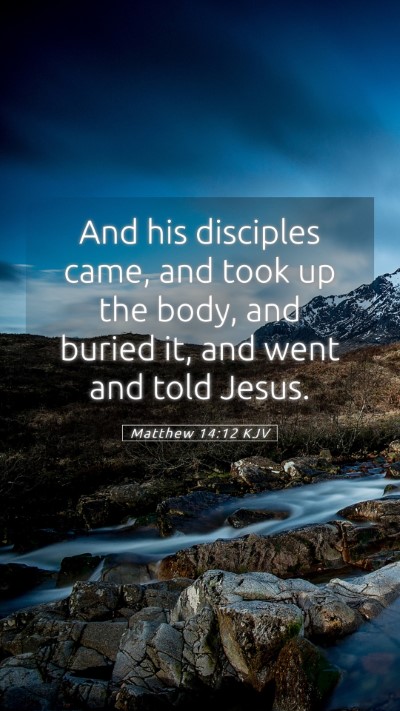Understanding Matthew 14:12
In Matthew 14:12, the verse reads:
"And his disciples came, and took up the body, and buried it, and went and told Jesus."
This verse is a poignant moment following the death of John the Baptist. It reveals actions taken by his disciples in response to this tragedy, emphasizing themes of mourning, discipleship, and the relationship between Jesus and His followers.
Bible Verse Meanings
This verse illustrates a critical event in the narrative of Jesus' ministry and the impact of John the Baptist's role. Below are the insights gathered from esteemed public domain commentaries:
-
Matthew Henry’s Commentary:
Matthew Henry explains that this verse reflects the reverence John’s disciples had for him. They mourned his loss by giving him a proper burial, which demonstrates their loyalty and respect. This act indicates the gravity of John's ministry and the impression he left on those who followed him.
-
Albert Barnes’ Notes on the Bible:
Barnes discusses the necessity of the disciples' actions following John's death. He indicates that taking up the body for burial signifies a closure to John's earthly ministry and sets the stage for the continuation of Jesus' mission. It also highlights the sorrow felt by those who followed John, contrasting with the reception that Jesus would face.
-
Adam Clarke’s Commentary:
Clarke goes deeper into the motivations of the disciples. He acknowledges that their actions were both an act of mourning and a demonstration of their commitment to John’s call. Clarke emphasizes that their going to tell Jesus reflects their belief in Jesus’ authority and the hope they had found in Him.
Bible Verse Interpretations
The interpretations of Matthew 14:12 draw a broader picture of discipleship, loss, and the weight of spiritual legacy:
-
Discipleship and Loyalty:
This verse encapsulates the model of true discipleship—loyalty to a leader and mourning loss while simultaneously seeking guidance from Jesus. It serves as a reminder of the importance of community and support among believers, especially in times of grief.
-
Transition in Ministry:
The moment signifies a pivotal transition as John the Baptist's ministry comes to a close, paving the way for Jesus' public ministry. It reflects the continuity of God's plan through different messengers and signals the onset of a new phase in the Gospel narrative.
-
Emotional and Spiritual Response:
The mourning of John's disciples highlights the emotional depth in spiritual journeys. It urges readers to understand that grief is part of life, particularly in the realm of faith where loss can lead to deeper insights and reliance on God's provision.
Bible Verse Understanding
The understanding of this verse in the context of the whole chapter includes themes of recognition, role of prophets, and the human response to loss:
-
Recognition of Prophets:
John the Baptist is recognized as a prophet of great importance, and his death is a significant loss to those who followed his message. The act of burial signifies respect for God's messengers.
-
Human Response to Tragedy:
Matthew 14:12 provides a window into the natural human response to tragedy—mourning and taking action. It serves as a model for how believers today can navigate their own experiences of loss.
-
Formation of Community:
The actions of the disciples serve to illustrate the early formation of community among Jesus' followers, showcasing how shared grief can bond people together in faith.
Bible Verse Explanations
In explaining the deeper meanings, several points emerge:
-
Significance of John the Baptist:
John's prophetic role is crucial to understanding the fulfillment of Old Testament prophecies, preparing the way for the Messiah, and his death underscores the cost of prophetic ministry.
-
Disciple's Assurance in Jesus:
The disciples’ immediate action to inform Jesus of John's death demonstrates their trust in Him to address their grief and confusion, pointing to Jesus' empathy and leadership.
-
The Call to Action:
This verse is also a call to action for modern believers to rise after loss, seek support among their community, and continue to fulfill their spiritual mission.
Related Bible Cross References
- Mark 6:29: Discusses the burial of John in a parallel account.
- Matthew 3:1-3: Details the role of John the Baptist as a forerunner to Christ.
- Luke 7:28: Acknowledge Jesus’ view of John as the greatest of prophets.
Conclusion
Matthew 14:12 encapsulates profound themes of loss, community, and the transitions of ministry, key for understanding the early church's dynamics and the life of Jesus. Grasping the meanings and applications from this verse is an essential part of Bible verse analysis and enhances personal Bible study insights.


